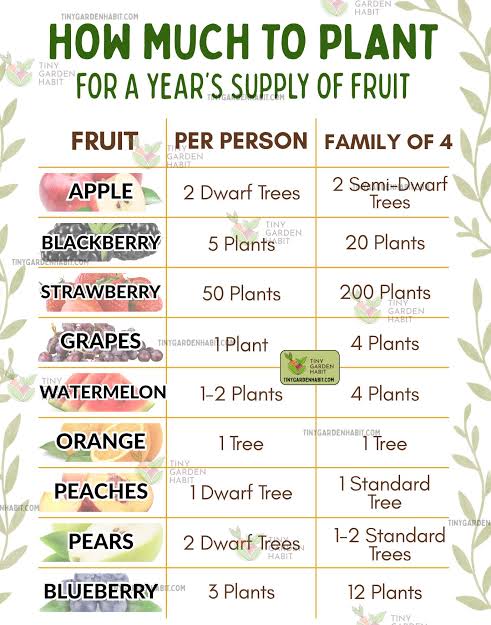Planning a self-sufficient garden—one that can feed you and your family for a full year—may sound overwhelming, but with the right strategy, it’s absolutely achievable. Understanding how much to plant per person for a year helps you avoid shortages, reduce waste, and make the most of your garden space. Whether you want to grow vegetables, herbs, or fruits, a smart plan ensures you harvest enough to eat fresh, preserve, and enjoy year-round.In this guide, you’ll discover simple tricks to how much to plant per person for a year successfully, plus practical tips, yield charts, and planning strategies even beginners can follow.🌱 Why It Matters: Growing Enough Food for a YearGrowing your own food offers major benefits:Reduces grocery costsEnsures fresher, healthier produceHelps you become more self-reliantSupports sustainable, eco-friendly livingBut the biggest challenge is knowing how much of each crop your household actually needs. Plant too little, and you’ll run out by fall. Plant too much, and you’ll drown in zucchini. The goal is balance—and that starts with smart planning.🥕 How Much to Plant Per Person for a Year: The EssentialsBelow is a beginner-friendly guide showing approximate quantities needed per person per year, based on average consumption.These estimates include both fresh eating and preserving (freezing, canning, drying).🥬 Vegetables: Recommended Planting Quantities🥕 Root VegetablesCarrots: 30–50 feet of rowPotatoes: 20–30 lbs of seed potatoes (yields 100–150 lbs)Beets: 10–20 feetOnions: 40–60 bulbs or starts🥦 Leafy GreensLettuce: 20–30 heads per yearSpinach: 20–30 feet of rowKale: 3–5 plants (very productive)🍅 Popular Garden StaplesTomatoes: 5–8 plants (fresh + sauces)Peppers: 5–10 plantsCucumbers: 4–6 plants🌽 Large ProducersSweet Corn: 40–60 plantsWinter Squash: 3–4 plantsZucchini: 2–3 plants🍓 Fruits: How Much to Plant Per Person🍓 BerriesStrawberries: 10–20 plantsRaspberries: 5–10 canesBlueberries: 2–3 bushes🍎 Tree Fruits(These take time to mature.)Apples: 1–2 trees per personPeaches: 1–2 treesPears: 1–2 trees🌿 Herbs: Yearly QuantitiesMost herbs are highly productive.Here are simple yearly estimates:Basil: 2–4 plantsParsley: 2 plantsCilantro: Plant every 2–3 weeks (it bolts fast!)Oregano: 1 plantRosemary: 1 bush🌾 Simple Tricks to Plan Successfully🌟 1. Think in Meals, Not Just PlantsInstead of guessing, ask:How many times do we eat carrots per week?How much tomato sauce do we use yearly?Do we snack on fresh fruit daily?Plan crops based on your actual eating habits.🌟 2. Use Succession PlantingThis allows you to grow more food in less space:Plant lettuce every 2–3 weeksReplant peas with bush beansReplace spring crops with fall cropsYou’ll get more harvests from the same beds.🌟 3. Choose High-Yield CropsFor small gardens, focus on:TomatoesGreensPotatoesCucumbersBeansThese produce heavily with little space.🌟 4. Track Your HarvestA simple notebook or phone app helps you record:How much you plantedHow much you harvestedWhat you needed more or less ofNext year becomes even easier!🌟 5. Preserve Your ExtraTo eat garden food all year:Freeze: berries, veggies, herbsCan: tomatoes, green beans, soupsDehydrate: herbs, apples, onionsFerment: cabbage, carrots, jalapeñosWith proper preservation, summer food lasts through winter.🧮 Sample Year-Round Garden Plan (1 Person)Here’s a simple sample layout:8 tomato plants10 pepper plants30 ft carrots20 ft beets20 heads lettuce (succession planted)20 ft spinach20–30 lbs seed potatoes6 cucumber plants2 zucchini plants3 winter squash plants40–60 corn stalks10 strawberry plants2 blueberry bushesHerbs: basil, parsley, cilantro, oregano, rosemaryThis plan provides plenty for fresh eating + preserving.🌻 ConclusionWith these simple tricks to how much to plant per person for a year successfully, you can confidently grow enough food to sustain yourself or your family. It’s all about planning smart, choosing productive crops, and understanding your household’s eating habits. Whether you’re gardening in a small backyard, raised beds, or a larger plot, these tips help you get the most out of every square foot.

